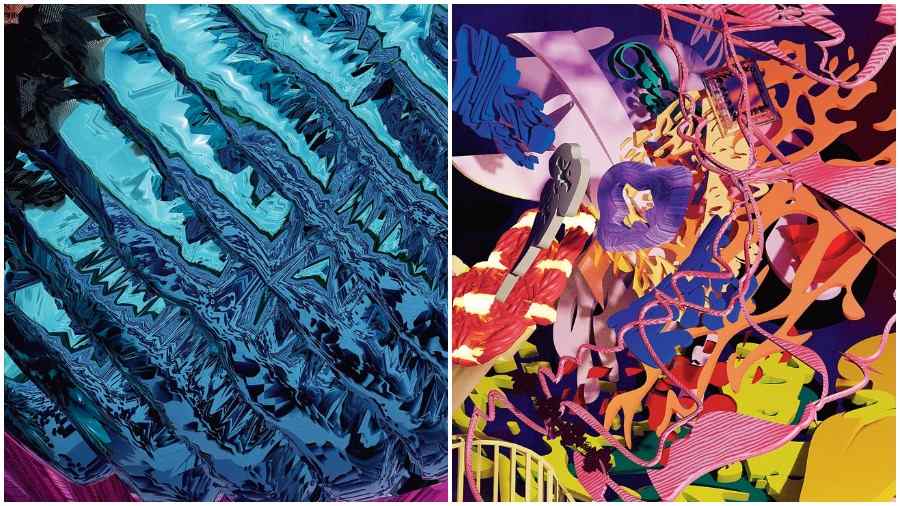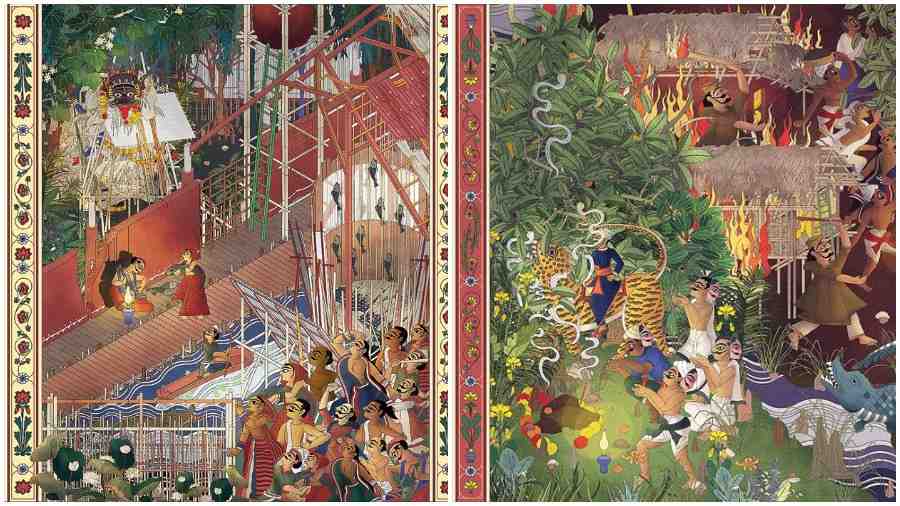NFTs (Non-fungible Tokens) — you can hate them or love them but you cannot ignore them any longer. And if that wasn’t amply clear, art magazine ArtReview deftly placed ERC-721 on top of its coveted Power 100 list, this year. For the uninitiated, ERC-721 is an Ethereum standard used to create NFTs and is the first non-human entity to have made it to this annual list that is in its 20th year. This, in context of the raging popularity of NFTs in the last year that has disrupted the world in general and the art market in particular, makes absolute sense. Record-breaking auctions have seen new-age sellers and buyers emerge with collections like the Bored Ape Yacht Club and CryptoPunks, and artists like Beeple and Pak creeping into our art parlance. And closer home, Terrain.art has embraced the space with vigour as they go about their objective of creating a holistic platform for both buyers and sellers in the NFT world.
Founder Aparajita Jain had instituted the company in 2019, much before NFTs became the buzzword and it was triggered by her own belief that blockchain was the answer to the problems of provenance, transparency and democracy in the traditional art world. And in her efforts to be more inclusive, Terrain.art now has a two-pronged approach in the form of a curated marketplace and a new open platform called Terrain Open that was launched more recently. “The entire idea is to be inclusive so we are going to have a curated section with six curators working with artists to help them come up with their programming and then we also have Terrain Open that is absolutely democratic. So we are looking at balancing both and we have some amazing drops coming our way,” Jain explained.
A holistic approach
Curation for the platform also comes from the point of view of both bridging the gap of know-how as well as acting as mediators. “The idea is to filter, to present the best there is and to build trust. We want to help build best practices. The young and emerging artists need support and we are looking at the holistic aspect,” said Jain. Srinivas Aditya Mopidevi, curator at Terrain.art also added more perspective to this as he explained how curating for the platform meant “working with artists who have gone through, for example, a representational model”, where they worked with them closely as curators, “put up their profiles and artwork, make their online exhibition and all of that structure, which has been going on for a little over a year”. But to make the marketplace more inclusive, Terrain Open works, as the name suggests, as an open platform, inviting multifaceted artists to mint their artworks on it. And they seem to be on the right track as Jain pointed out how they have already “crossed over Rs2 crore in sales” with around 80 artists already working with them.
Roadblocks and solutions
But of Jain’s own admission, India is still lagging behind when it comes to awareness about NFTs in general. Therefore, the platform has also taken over the daunting task of sensitising people about what NFTs are; risks and gains included. “One of the things that we have set out to do from the beginning is to also simultaneously educate the Indian audience about NFTs, their importance and how they have changed the way art is circulated, how the royalties are configured and the provenance is defined — and this includes the artists. It is simultaneously trying to spread the word as well as putting up systems where we can eventually include global communities of artists on the platform,” said Mopidevi.
Checks and balances
Along with an emerging market comes its own set of risks and problems and Terrain.art has tried to counter that with its own system of checks, balances and redressal. “We have a band of lawyers that are working with us. We have a redressal system and lawyers that we put people in touch with if there seems to be a plagiarism or IPO problem,” said Jain. Talking about the threat of plagiarising the “language” of an artist, Mopidevi pointed out how they have a system of vetting and in case of allegations of copying, they have a review process in place. “The code of ethics and processes existing within the traditional forms of art are still being figured out, in (context to) the NFT world. Even though some of them have been translated into this space, there is still a grey area where these things are being instituted as a process. Until these regulations are properly in place, there still remains a little bit of vulnerability,” he added.
Mopidevi also pointed out the challenge that the world of NFTs brings forth about understanding its “relationship” with art and how expensive minting can be, which might deter young artists from walking down this road. “A lot of people think NFT is art-making but that’s not true. NFT is just a qualifying mechanism that authenticates and gives a particular unique ID to the artwork, which is often for a digital artwork in this case but can also be used for a physical artwork. The challenge is that Ethereum, for example, is very expensive and a lot of young artists who do not have the resources wouldn’t be able to afford the gas fee, which is quite high. Even if it is $60-$70 and the work costs $100-$200, you are spending a significant amount just for the gas fee,” he said. Terrain.art is tackling this issue by also offering Polygon as a standard of minting, which costs much less.

Close Up Shot of Crystalline Scalish Object Merging Into a Pectoral Object, 2020 (left) and Norganic Objects Moving to Hyper-concrete Jazz Movements Captured During a Reprogramming Protest Meet, 2020 by Calcutta-based artist, Subhojyoti Sen Sarma on Terrain Open
Artistically speaking
As for artists, their challenges seem to be surrounding the digital medium and the scepticism that that brings forth. “What immediately strikes me is the challenge of translating the technical aspects of the crypto space. Most marketplaces are plagued with uncertainty. Within the NFT market, the general idea of digital art is an edition-based reiterating piece of work, tethered to the concept of collectibles — and this can be problematic. I remain sceptical about the de-centralisation aspect of the crypto-economy; as it is generated from the libertarian ideologies of de-regulation and omission of oversight in marketplaces, trade and governance. However, this is not applicable for every crypto-based marketplace or DAOs (De-centralised Autonomous Organisation). One can see how the digital marketplaces reflect the same prestige-based model of the contemporary fine art market, and its economic and political ramifications,” said Calcutta-based Subhojyoti Sen Sarma, an artist who has his work on Terrain Open. Meanwhile, Calcutta-born Arinjoy Sen, of his own admission, had no intention of working with NFTs and the reason for his hesitation is the lack of general awareness about NFTs and therefore, the uncertainty amongst many to interact with digital art.
However, both remain hopeful about overcoming these challenges. Sarma believes that forming DAOs among like-minded artists and creators could work and that it could “grow to a stage where such organisations could provide safety nets for artists, build a democratic, fair and free market, and a viewer-collector-creator nexus”. And Sen, despite his hesitation, has reached a negotiation where his physical artworks are authenticated as NFTs by Terrain.art and is of the opinion that the challenges surrounding the lack of awareness could be dealt with by galleries stepping up to educate more people.
The boon and bane of speculation
Speculation regarding this new domain of NFTs is perhaps the most common problem surrounding it but Terrain.art is using it as a catalyst to beget exciting new art in the form of a series of commissioned works called Non-fungible Speculations, curated by Beth Citron and Mopidevi that launches on April 25. “This is the first time we have commissioned very established artists in India and south Asia to reflect on the very idea of what NFT is to them as at the end of the day, NFTs come with certain speculations. Some of the artists include Raqs Media Collective, Jitish Kallat and Thukral & Tagra, and their works will reflect on the idea of “speculation”, especially in the context of the pandemic where everything has become speculative. We also wanted to critically reflect on the idea of NFTs and not just keep talking about it and valorising it. NFTs have a democratic possibility but we have to proceed with some form of caution,” said Mopidevi, while talking about their upcoming drop.
So while we wait and watch to find out about the long term effects of NFTs on the art world, we must also credit this same element of speculation for all the buzz surrounding this new domain as Mopidevi rightly summed up — “The tenacity of speculation in this space is way more unpredictable than many other markets or exchanges so far, and that is also what more people have gravitated towards.”
Pictures: Courtesy of artists and Terrain.art
Terrain.arrt can be accessed at www.terrain.art










